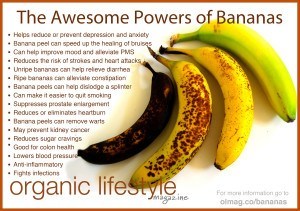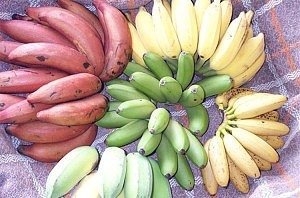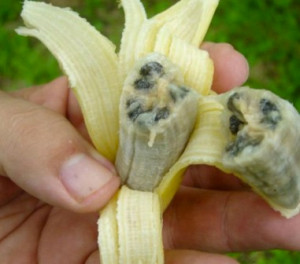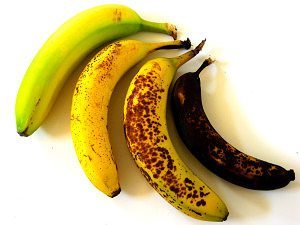Bananas Are Good For…
Bananas are good for constipation, skin problems, heart, nervous system, PMS, anemia, kidneys, bones, stomach ulcers, indigestion, emotional state, blood circulation, hangovers, rheumatic aches and pains, blood pressure, morning sickness, and muscular regeneration.
When you compare a banana to an apple, bananas have four times the protein, twice the carbohydrates, three times the phosphorus, five times the vitamin A, five times the iron, and two times the vitamins and minerals.
And, of course bananas are well known for being rich in potassium. Nutritionally, bananas are one of the best value foods available.
Contents
Nutrition Composition Of Bananas
Bananas contain lots of manganese, vitamin B6 and vitamin C. Bananas also contain health-promoting flavonoids, polyphenolics, such as lutein, zeaxanthin, beta, and alpha carotenes (acting as free radical-gobbling antioxidants).
Bananas are well known for their potassium. Just one banana contains 422 mg of potassium (depending on its size), which is important for controlling your heart rate and blood pressure, as well as a host of other functions.
Nutrition Facts for One Medium Sized, Raw, Typically Ripe Banana, 120g
| Calories: |
105 |
3 calories from fat |
| Total Fat: |
0g |
1% |
| Saturated Fat: |
0g |
1% |
| Trans Fat: |
0g |
|
| Cholesterol: |
0mg |
0% |
| Sodium: |
1mg |
0% |
| Total Carbohydrate: |
27g |
12% |
| Dietary Fiber: |
6g |
23% |
| Sugars: |
14.4g |
(varies with ripeness) |
| Starch: |
6.3g |
(varies with ripeness) |
| Protein: |
1.3g |
3% |
|
|
|
Vitamins
|
|
|
| Vitamin A |
75.5 IU |
2% |
| Vitamin C |
10.3 mg |
17% |
| Vitamin D |
0 |
0% |
| Vitamin E |
0.1 mg |
1% |
| Vitamin K |
0.6 mcg |
1% |
| Thiamin |
0.0 mg |
2% |
| Riboflavin |
0.1 mg |
5% |
| Niacin |
0.8 mg |
4% |
| Vitamin B6 |
0.4 mg |
22% |
| Folate |
23.6 mcg |
6% |
| Vitamin B12 |
0 mcg |
0% |
| Pantothenic Acid |
0.4 mg |
4% |
| Choline |
11.6 mg |
|
| Betaine |
0.1 mg |
|
|
|
|
Minerals
|
|
|
| Calcium |
5.9mg |
1% |
| Iron |
0.3 mg |
2% |
| Magnesium |
31.9mg |
8% |
| Phosphorus |
31.9 mg |
8% |
| Potassium |
422 mg |
12% |
| Sodium |
1.2 mg |
0% |
| Zinc |
0.2 mg |
1% |
| Copper |
0.1 mg |
5% |
| Manganese |
0.3 mg |
16% |
| Selenium |
1.2 mcg |
2% |
| Fluoride |
2.6 mcg |
|
|
|
|
Glycemic
|
Load |
10
|
|
Index
(glucose = 100)
|
50
(30-70 depending on ripeness)
|
Natural Remedies and Prevention With Bananas
Bananas help overcome depression, relieve seasonal effective disorder, and are great for elevating mood, reducing PMS symptoms, and reducing stress due to high levels of vitamin B6 and tryptophan and its ability to regulate blood sugar levels.
A study conducted by the Imperial College of London found that children who ate a banana every day had a 34% less chance of developing asthma.
Bananas help protect against muscle cramps during workouts and nighttime leg cramps. The high fiber in bananas can help normalize bowel motility (constipation relief). But if you have the runs, bananas can soothe and help normalize the digestive tract. Bananas also restore electrolytes that are lost from diarrhea. Green bananas are known to reduce or eliminate diarrhea.
Bananas alleviate heartburn (acid reflux). They are a natural antacid. Some people with stomach ulcers have problems with other raw produce, but bananas are the only raw fruit that can almost always be consumed without distress from ulcers because they coat the lining of the stomach against corrosive acids. Bananas, along with the right diet, can help heal stomach ulcers.
Eating bananas will help prevent kidney cancer, protect the eyes against macular degeneration, and increase calcium absorption. Eating bananas between meals helps to stabilize blood sugar and reduces nausea due to morning sickness.
Bananas can help reduce binge eating, as they help stabilize blood sugar.
Banana Peel Uses and Remedies
Banana peels can remove warts. Put a piece of banana peel against the wart (inside of peel against skin) and tape it in place. Rub the inside of a banana peel on bug bite or hives to relieve itching and irritation. With its healing and regenerative properties, banana peel can speed up the healing of bruises, scraps, scratches, and other injuries.
Rub the inside of a banana peel on leather (like shoes or a handbag) to polish; follow with a dry cloth for a quick shine.
Rub the inside of a banana peel on your teeth for a couple of minutes every other day for whiter teeth.
 While you’re at it, if you suffer from acne, try rubbing a peel over acne every night. The inside of banana peel can soothe the inflammation and irritation of acne and help prevent future outbreaks. You should see results in a few days.
While you’re at it, if you suffer from acne, try rubbing a peel over acne every night. The inside of banana peel can soothe the inflammation and irritation of acne and help prevent future outbreaks. You should see results in a few days.
Other skin issues that benefit from the inside of a banana peel include sunburn, psoriasis, poison ivy rash, and other rashes that are not Candida related. Rubbing the peel ob the forehead, face and cheeks can tighten the skin, shrink pores, and reduce wrinkles
The enzymes in banana peels can help dislodge a splinter. Try taping a piece of the peel (inside to skin) over a splinter for two hours.
Banana peels are great for compost.
Banana History and Culture
Bananas were first referenced in sixth century BCE Buddhist writings in India. They were likely to have originated in Malaysia and transported by early explorers to India. Alexander the Great is said to have, after trying and liking bananas, brought the fruit back from India to the Western world.
 Bananas vary in size, color, firmness, and texture. Almost all modern edible seedless bananas come from the two wild species, Musa acuminata and Musa balbisiana.
Bananas vary in size, color, firmness, and texture. Almost all modern edible seedless bananas come from the two wild species, Musa acuminata and Musa balbisiana.
In some countries, especially in the Americas and Europe, banana varieties that are generally used for cooking are called plantains. However, in many countries there is no such distinction between the two. In other regions, such as Southeast Asia, there are many varieties of banana grown and eaten with a variety of textures and sizes with varying degrees of sweetness.
Eating Fully Ripe Bananas
Ripe bananas with brown spots or peels can act as an anti-cancer agent by stimulating the production of white blood cells in the human cell line. On the other hand, when bananas fully ripen and develop dark spots on the skin, the starch content changes to simple sugars which can raise the blood glucose levels quickly and feed Candida or infection. As bananas ripen, some of the micro-nutrients decrease as well.
Eating Raw Unripe Bananas
Most of the carbohydrates in our diet are starches found in grains, potatoes, and various other foods. But not all of the starch we eat gets digested. There is starch called “resistant starch,” found in raw potatoes and unripe bananas which functions in a similar manner as soluble fiber. This starch has significant health benefits including appetite reduction, improved insulin sensitivity, stabilization of blood sugar levels, and various other benefits that aid indigestion.
Banana Agriculture
Americans buy more bananas than any other fruit. The average American eats 10 pounds of bananas each year.
According to the USDA, in 2012, the U.S. imported 9,589 million pounds of bananas. More than 95 percent of the bananas are grown in five tropical Latin American nations.
Are There Genetically Modified Bananas?
 The bananas we eat from the grocery store are hybrid bananas. We have crossbred bananas in order to remove the seeds and to sweeten and soften the fruit.
The bananas we eat from the grocery store are hybrid bananas. We have crossbred bananas in order to remove the seeds and to sweeten and soften the fruit.
GMO bananas may be in our future. The International Institute of Tropical Agriculture and NARO, funded by the Rockefeller Foundation and CGIAR, have started trials for genetically modified bananas resistant to black sigatoka and banana weevils.
Organic Vs. Conventional Bananas
The conventional banana industry is pesticide intensive. Bananas are grown in massive monocultures without crop rotation, which causes plants to be vulnerable to insect pests and fungal diseases.
The pesticide procedure is believed to use 35 pounds of pesticide per acre, which is dramatically more than other crops (van Wendel de Joode 2012, citing Wesseling 2001 and Ramírez 2009). Each bunch of bananas on the trees are enclosed inside of a plastic bag where the chemicals are inserted. The good news is that few of the pesticides reach the edible tissue of the fruit, but the risk to workers’ health and the environment, is substantial.
Organic bananas grown without synthetic insecticides and fungicides are a bit more expensive than conventional bananas. Some report that the days of organic bananas may be limited. A highly virulent and incurable strain of a fungus that attacks the Cavendish banana is spreading across plantations around the world.
Peeled bananas are generally tainted with very few pesticide residues, according to USDA analyses, probably because those tested are peeled first. In 2012 USDA scientists found just four fungicides on bananas they analyzed, compared to 10 on plums (USDA 2012b).
Fair Trade Bananas
Certified Fair Trade labeled bananas are a better choice than conventional for a few reasons. Growers have agreed to some restrictions on toxic pesticides and greater protection and pay for their workers.
Banana Human Rights Issues
Though bananas are one of the most widely distributed products in the world, there is very little in way of regulations and laws in regards to the treatment of the plantation workers. Commonplace tactics include child labor, anti-union measures, substandard wages, and severe toxic exposure,
Latin America countries have been plagued by imperialist foreign policies of developed nations for over a century, and the banana industry has been a large source of such turmoil.” – The Tragedy of Trade
The major banana distributors of North America, being Dole Food Company and Chiquita Brand International, continue to exploit the people of Ecuador, ignoring international treaties and declarations, which both the United States and Ecuador have ratified.
If organic bananas are not available, look for bananas labeled fair trade.
Things You Didn’t Know About Bananas
To quickly ripen a banana, place it in a paper sack with a tomato or an apple.
Bananas are 75% water.
Even though bananas are very sweet when ripe, bananas have a relatively low glycemic index rating.
One banana supplies enough copper to keep the body properly producing red blood cells.
As they ripen, bananas produce an enzyme called “pectinase.” This enzyme helps break down plant materials in our body.
A banana has as much starch as a potato.
The fruit isn’t the only part of the banana you can eat. The flowers, leaves and trunk of the plant are edible as well.
How To Store Bananas So They Last Longer
If you’re one of those people who generally eats bananas quickly enough not to lose them to spoiling, you’ll benefit from a banana hanger (if you don’t already have one). If you need your bananas to last as long as possible, separate them and wrap each individual stem with plastic cling wrap. Lay them on padding such as a towel. Once bananas are at the desired ripeness, you can put them in the refrigerator. The banana skins will brown and eventually turn black in the fridge, but bananas are fine to eat.
Many people also peel bananas once they are ripe, put them in a plastic freezer bag, and then put them in the freezer for smoothies later.
How To Pick Good Bananas
 It all depends on how ripe your bananas should be when they are ready to eat. Ripe bananas, unripe bananas, and all varying ripeness of bananas in between have their own unique benefits. So the question is, how soon do you want to eat them? The greener the banana the longer it will take to ripen. The more brown there is the more ripe the banana is.
It all depends on how ripe your bananas should be when they are ready to eat. Ripe bananas, unripe bananas, and all varying ripeness of bananas in between have their own unique benefits. So the question is, how soon do you want to eat them? The greener the banana the longer it will take to ripen. The more brown there is the more ripe the banana is.
Always look for organic bananas or fair trade bananas. They typically taste better in our opinion, and there is much less environmental degradation and no human rights abuses with these labels.
Things To Consider
When we are healthy and our body’s digestive system is balanced, bananas are very good for us. On the other hand, when someone is suffering from Candida overgrowth, bananas feed yeast.
Beta-blockers, medications that are most commonly prescribed for heart disease, can cause potassium levels to increase in the blood. High potassium foods such as bananas should be limited if you are taking beta-blockers.
Consuming great amounts of potassium can be harmful for people with poorly functioning kidneys. If your kidneys are unable to remove excess potassium from the blood, too much potassium may be fatal. For anyone dealing with Candida or any other infections would do well to limit or avoid bananas (and check out Make Your Immune System Bulletproof and Gluten Candida, Leaky Gut Syndrome, and Autoimmune Diseases.
Recommended Reading:
Banana Recipes:
Sources & Further Reading:



